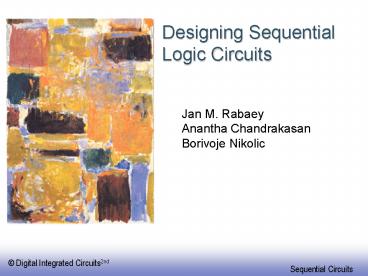Designing Sequential Logic Circuits - PowerPoint PPT Presentation
1 / 47
Title:
Designing Sequential Logic Circuits
Description:
of the first inverter Digital Integrated Circuits2nd. Sequential Circuits ... aperture (setup hold) and clock to Q assuming the output load is 2 min inverters. ... – PowerPoint PPT presentation
Number of Views:195
Avg rating:3.0/5.0
Title: Designing Sequential Logic Circuits
1
Designing SequentialLogic Circuits
Jan M. Rabaey Anantha Chandrakasan Borivoje
Nikolic
2
Sequential Logic
2 storage mechanisms positive feedback
charge-based
3
Naming Conventions
- In the text
- a latch is level sensitive
- a register is edge-triggered
- Many different naming conventions
- flip-flops (level or edge?)
- Transparency?
- Dual edge/level
4
Latch versus Register
- Register- stores if clock rises, never
transparent (mostly)
- Latch- stores if clock is low transparent if
clock is high
D
Q
D
Q
Clk
Clk
Clk
Clk
D
D
Q
Q
5
Latch-Based Design
- N latch is transparentwhen f 0
- P latch is transparent when f 1
f
N
P
Logic
Latch
Latch
Logic
6
Timing Definitions
CLK
Register
t
D
Q
t
t
hold
setup
D
DATA
CLK
STABLE
t
t
c
lk2q
Q
DATA
STABLE
t
7
Maximum Clock Frequency
f
Timing Constraints tclk2q tp(comb) tsetup
T tcdreg tcdlogic gt thold First Constraint
ensures clock is slow enough that Registers
sample correct value Second Constraint ensures
that there is no path after the clock changes to
alter the previously stored data
Register
LOGIC
t
P(comb)
8
Positive Feedback Bi-Stability
1
1
o
o
V
V
5
2
i
V
A,B Stable points C is unstable(metastable) Feedb
ack moves state to Stable points, eventually
1
o
V
5
2
i
V
V
V
V
V
V
V
i
1
o
2
o
2
i
1
o
1
i
2
9
Writing a Static Latch
Use the clock to distinguish between the
transparent and opaque states
Forcing the state (can implement as NMOS-only)
Converting into a MUX
10
Mux-Based Latches
Negative latch (transparent when CLK 0)
Positive latch (transparent when CLK 1)
CLK
11
Master-Slave Register
CLK
D
Qm
Qm
Q
D
Q
CLK
CLK
Two opposite latches trigger on edge Also called
master-slave latch pair
12
Clk-Q Delay
Clock to Q delays are Different for rising and
falling Transitions Use Worst Case not Avg!
13
Setup Time (MS register)
Q
Qm
D
Q
D
Qm
CLK
Setup 0.20nS Failed to pass D
Setup 0.21nS Passed D
14
Cross-Coupled Pairs
NOR-based set-reset
Q Q 0 1 -
Q Q 1 0 -
R 0 0 1 1
S 0 1 0 1
S
Q
R
Q
15
Cross-Coupled NAND
16
Sizing Issues
2
W0.5
1
Q (V)
W0.7
W0.8
2.5
3.5
3.0
1
0
2
W1
W/L (M5,M6) M26
Output voltage dependence on transistor width
Transient response
17
Storage Mechanisms
Dynamic (charge-based)
Static
CLK
D
Q
CLK
18
Making a Dynamic Latch Pseudo-Static
19
Setup/Hold Time Illustrations
Circuit before clock arrival (Setup-1 case)
20
Setup/Hold Time Illustrations
Circuit before clock arrival (Setup-1 case)
21
Setup/Hold Time Illustrations
Circuit before clock arrival (Setup-1 case)
22
Setup/Hold Time Illustrations
Circuit before clock arrival (Setup-1 case)
23
Setup/Hold Time Illustrations
Circuit before clock arrival (Setup-1 case)
24
Setup/Hold Time Illustrations
Hold-1 case
0
25
Setup/Hold Time Illustrations
Hold-1 case
0
26
Setup/Hold Time Illustrations
Hold-1 case
0
27
Setup/Hold Time Illustrations
Hold-1 case
0
28
Setup/Hold Time Illustrations
Hold-1 case
0
29
Other Latches/Registers C2MOS
Keepers can be added to make circuit
pseudo-static
30
Insensitive to Clock-Overlap
V
V
V
V
DD
DD
DD
DD
M
M
M
M
2
6
2
6
M
0
0
M
4
8
X
X
D
Q
D
Q
M
1
M
1
3
7
M
M
M
M
1
5
1
5
(a) (0-0) overlap
(b) (1-1) overlap
31
Pipelining
32
Other Latches/Registers TSPC
33
Pulse-Triggered LatchesAn Alternative Approach
Ways to design an edge-triggered sequential cell
Master-Slave Latches
Pulse-Triggered Latch
L1
L2
L
Data
Data
D
Q
D
Q
D
Q
Clk
Clk
Clk
Clk
Clk
34
Latch-Based Pipeline
CLK
CLK
CLK
F
G
F
G
35
Non-Bistable Sequential Circuits-Schmitt Trigger
- VTC with hysteresis
- Restores signal slopes
36
Noise Suppression Schmitt Trigger
37
CMOS Schmitt Trigger
Moves switching threshold of the first inverter
38
Schmitt Trigger Simulated VTC
2.5
2.5
2.0
2.0
V
1.5
1.5
M
1
(V)
(V)
x
X
V
1.0
1.0
V
V
M
2
k
1
k
3
k
2
0.5
0.5
k
4
0.0
0.0
0.0
0.5
1.0
1.5
2.0
2.5
0.0
0.5
1.0
1.5
2.0
2.5
V
(V)
V
(V)
in
in
Voltage-transfer characteristics with hysteresis.
The effect of varying the ratio of the
PMOS device
M
. The width is
k
0.5 m.
m
4
39
CMOS Schmitt Trigger (2)
40
Multivibrator Circuits
41
Transition-Triggered Monostable
42
Monostable Trigger (RC-based)
43
Astable Multivibrators (Oscillators)
44
Relaxation Oscillator
45
Voltage Controller Oscillator (VCO)
46
Differential Delay Element and VCO
two stage VCO
simulated waveforms of 2-stage VCO
47
Homework 7
- A common way to characterize registers is to
measure the timing aperture which is the total
window in which transitions on data are not
correctly output. This is done by making two
clocks which are close, but not the same so that
the relative phase drifts slowly with each cycle.
Construct a pseudo-static master/slave flip-flop
in SUE with the assumption that the input is
driven by a unit inverter (2/1, min width nmos),
the clock is driven by a 2x inverter. Optimize
your designs to minimize the timing aperture
(setuphold) and clock to Q assuming the output
load is 2 min inverters. Simulate your designs in
SPICE and turn in both the designs (annotated
schematics and spice results plz. dont waste
paper!) - Do problem 1 again, with TSPC based flipflop.
(High performance)































